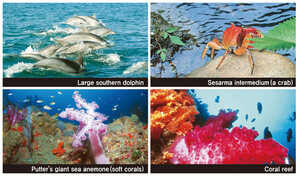hankyoreh
Links to other country sites 다른 나라 사이트 링크
As Gureombi Rock goes, precious nature dies with it

BY Huh Ho-joon, Jeju Correspondent
According to village residents, Gureombi Rock got its name from the numerous “gureombi” trees around the coast. In the Jeju dialect, the word refers to the Listea japonica tree, which grows even today all around the Gureombi coast.
But the special rocks and the life that surrounds it are now on their way out. Its demolition signifies the real beginning of construction on the Jeju naval base. This has led to a number of scuffles around the site between security forces and protestors, who have used protection of the rock as a last-ditch effort to block the base‘s construction.
The main Gureombi Rock is enormous, measuring 1.2 km long and over 250 meters across. The Navy and residents expect the demolition effort to take a long time due to weather conditions and the rock’s massive size.
“If you take into account the fact that we need to avoid rain and other weather conditions, it may take around three to four months,” a Navy official said.
Arriving at the broad expanse of the Gureombi coast, one is immediately greeted by the sight of Beom and Seogeon Islands, which seem close enough to touch. In 2002, the coastal area here was designated as a UNESCO Biosphere Reserve. The waters off the coast were designated as a marine ecosystem protection zone by the Ministry of Maritime Affairs and Fisheries that same year, and a Cultural Heritage Administration natural monument protection zone in 2004. In essence, the area‘s preservation value has been acknowledged by both the international community and the South Korean government.

The Gureombi coast is also a habitat for the red-footed crab, narrow-mouthed toad and wild fauna designated as endangered by the Ministry of Environment. The Jeju saebaengi, a freshwater shrimp that is a candidate for endangered species status, has been found there, as has the Cladium chinense, a rare variety of flora. All of these endangered species will gradually disappear as the construction effort continues.
It is currently impossible to pass through the coastal area, which the Navy has fenced off, but it is passed by the seven most popular Jeju Olle (Olle means ‘village path’ in Jeju’s regional dialect) hiking trails. At Gureombi, people hiking the paths can feel nature on their bare feet. Olle aficionados also say the area has high value as a tourist attraction.
Taking note of the Gureombi coast’s value, Jeju Provincial Government designated it as an area of absolute protection in October 2001, making any change to it effectively impossible. But the regions had their protected status lifted in a Dec. 2009 railroading by the Jeju Provincial Council.
The coast is also an essential resource for residents. The artesian springs throughout the region were a source of potable water for villagers in the past. In particular, Halmangmul was regarded as a sacred spring by villagers holding ancestral rites.
“Even since I was child, I gathered turban shells and caught fish to cook at Gureombi Rock,” a villager said, adding that it was “like a hometown for my heart.”
Jeju Korea Federation for Environmental Movements secretary-general Lee Yeong-ung said that all of the roughly twenty artesian springs in the Gureombi Rock coastal area are freshwater wetlands.
“The croaking of frogs from the Gureombi coast in the summertime is enough to leave you in a trance,” Lee said.
But that sound is poised to stop forever if the government plan continues as scheduled. In its place will be a massive concrete structure.
Please direct questions or comments to [englishhani@hani.co.kr]
Editorial・opinion
![[Guest essay] The real reason Korea’s new right wants to dub Rhee a founding father [Guest essay] The real reason Korea’s new right wants to dub Rhee a founding father](https://flexible.img.hani.co.kr/flexible/normal/500/300/imgdb/original/2024/0423/8317138574257878.jpg) [Guest essay] The real reason Korea’s new right wants to dub Rhee a founding father
[Guest essay] The real reason Korea’s new right wants to dub Rhee a founding father![[Column] ‘Choson’: Is it time we start referring to N. Korea in its own terms? [Column] ‘Choson’: Is it time we start referring to N. Korea in its own terms?](https://flexible.img.hani.co.kr/flexible/normal/500/300/imgdb/original/2024/0423/3617138579390322.jpg) [Column] ‘Choson’: Is it time we start referring to N. Korea in its own terms?
[Column] ‘Choson’: Is it time we start referring to N. Korea in its own terms?- [Editorial] Japan’s rewriting of history with Korea has gone too far
- [Column] The president’s questionable capacity for dialogue
- [Column] Are chaebol firms just pizza pies for families to divvy up as they please?
- [Column] Has Korea, too, crossed the Rubicon on China?
- [Correspondent’s column] In Japan’s alliance with US, echoes of its past alliances with UK
- [Editorial] Does Yoon think the Korean public is wrong?
- [Editorial] As it bolsters its alliance with US, Japan must be accountable for past
- [Guest essay] Amending the Constitution is Yoon’s key to leaving office in public’s good graces
Most viewed articles
- 1[Guest essay] The real reason Korea’s new right wants to dub Rhee a founding father
- 2Terry Anderson, AP reporter who informed world of massacre in Gwangju, dies at 76
- 3Why Korea shouldn’t welcome Japan’s newly beefed up defense cooperation with US
- 4[Column] ‘Choson’: Is it time we start referring to N. Korea in its own terms?
- 5Senior doctors cut hours, prepare to resign as government refuses to scrap medical reform plan
- 6Opposition calls Yoon’s chief of staff appointment a ‘slap in the face’
- 7[Column] The clock is ticking for Korea’s first lady
- 8New AI-based translation tools make their way into everyday life in Korea
- 9[Editorial] Japan’s rewriting of history with Korea has gone too far
- 10[Column] Are chaebol firms just pizza pies for families to divvy up as they please?